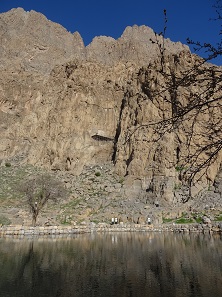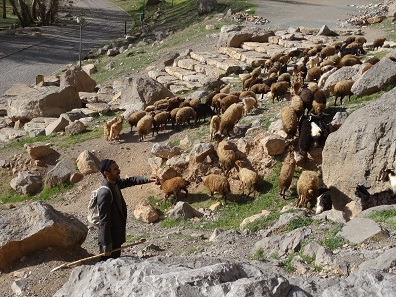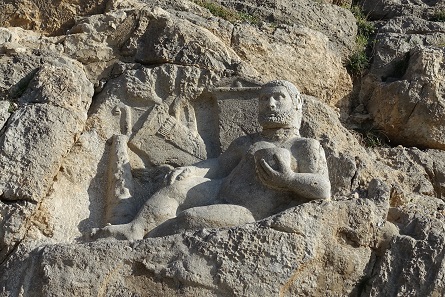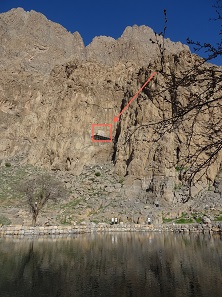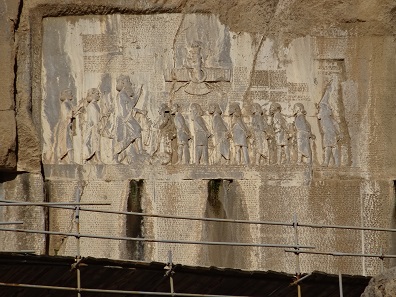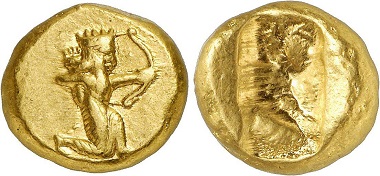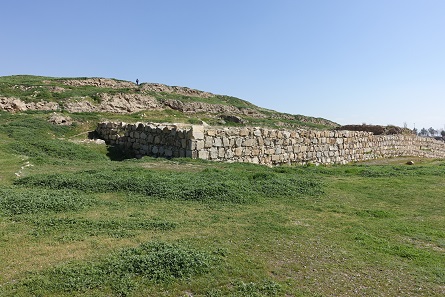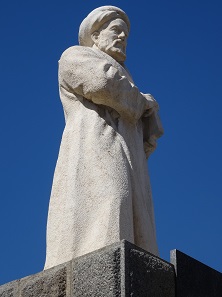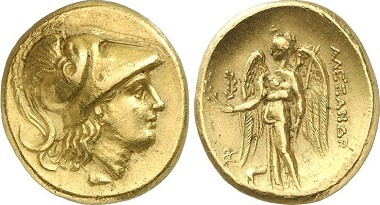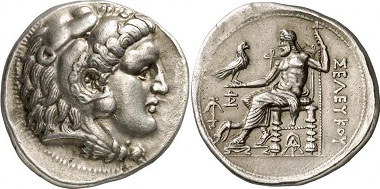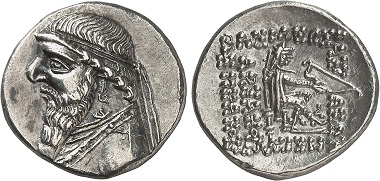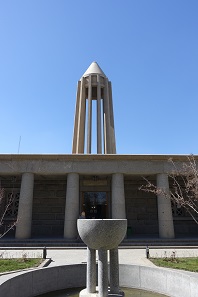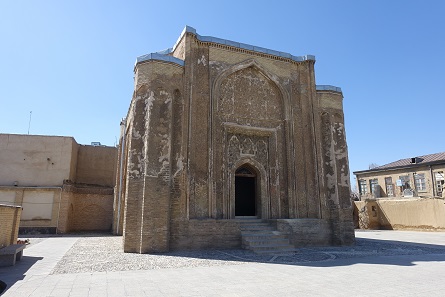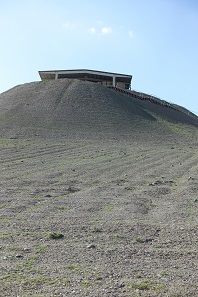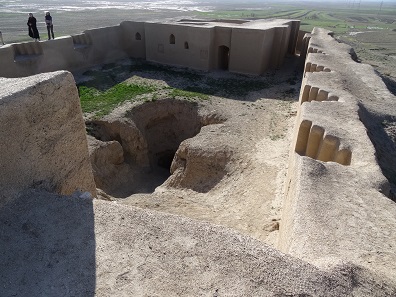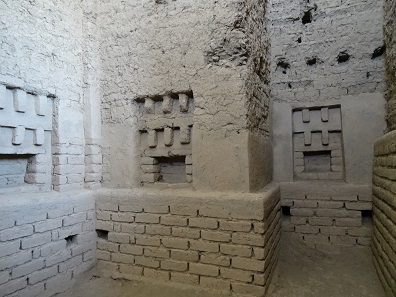by Ursula Kampmann
translated by Teresa Teklic
25 August 2016 – Do you know anything about the Medes? I admit my knowledge of this people doesn’t really exceed what I once read in Herodotus. And that wasn’t exactly a lot. Still, Herodotus’ writing forms the most comprehensive part of the written records about the Medes.
According to him the Medes don’t seem to have had an empire as we know it from the Persians. Instead they established a confederation of various tribal communities, which regarded themselves as military units, albeit with occasionally changing loyalties.
The Medes were famous for their horse breeding and horsemanship. Herodotus claims they owe that to the Scythians, who ruled over the Medes for 28 years according to his knowledge.
Herodotus goes into great detail when he describes the rule of Astyages, who went to war against Croesus, king of the Lydians. In this context the solar eclipse predicted by Thales of Miletus for the year 585 BC is also mentioned. It scared the two parties so much that they decided making peace was the safer bet.
Highlight of Herodotus’ history of the Medes is the fairy tale-like birth and childhood of Cyrus, who would later overthrow the Median King Astyages, his maternal grandfather according to Herodotus. Henceforth the Persians ruled over the Medes, while the latter took on an important role in the Persian Empire.
We don’t know how the Medes saw themselves. They didn’t leave us any written records. So only a number of archaeological sites tell us something about the Medes. And we’re going to see some of them in this episode.
Saturday, 12 March 2016
When we reached Bisotun at an ungodly hour, we had the loveliest weather. How I was looking forward to this! Today I’d see the famous stone relief! Everyone who has ever studied ancient history can picture this scene in mind: Darius I, standing in front of the tied-up impostor kings with his servants. “I am Darius,” begins the trilingual inscription, which has inspired many an author’s book title. So I had truly great expectations when I got off the bus in no time to see the massive relief.
Looking at the gigantic rock face. And yes, if you know where it is you can already begin to make out the relief. Photo: KW.
We were the only tourists on site. The location was visibly designed for bigger crowds. There even was a (closed) souvenir shop.
A shepherd was driving his sheep from pasture to pasture. Photo: KW.
We didn’t mind. Instead of tourists we were surrounded by sheep that a shepherd was driving along the high rock walls. The critters came across the crest at breakneck speed, jumping over rough and smooth, pushing against and through us, and were gone again before the last one of us could pull out his camera.
The Hercules version of Bisotun, a well-fed little fellow. Photo: KW.
The first archaeological attraction on the way was a portrayal of the lying Hercules from 148 BC, carved in the rock. Let’s put it like that: It really isn’t a highlight of Hellenic sculpting. Everybody made lame jokes about Hercules, who turned out somewhat on the short side and should try a little dieting some time. Poor guy! He has been through a lot. He already carries his third head since it gets stolen again and again.
The relief begins where the arrow ends. Photo: KW.
The path to the relief leads past Hercules. And when we stood in front of it we almost didn’t see it. Luckily several fellow travellers had brought powerful binoculars. The massive Bisotun rock relief measures around 5.50 m in width and 3 m in height, an impressive size for a relief that is installed at eye level. In fact it is carved into the rock at such a height that even the people in Achaemenid times couldn’t read the inscriptions. It is thus assumed that the inscription was read out loud by royal messengers in all Persian villages so that those who saw the Bisotun relief from the adjacent road knew exactly what it was meant to represent and what the inscription read.
This is what the relief looks like seen through a very powerful telephoto lens. Photo: KW.
The relief and its inscriptions are so interesting for historians because you can have endless arguments about the question who this impostor king Gautama was, whose downfall Darius I so triumphantly celebrates.
Darius I, after all, didn’t really have a claim to the Persian throne. He was merely the eldest son of the Satrap of Bactria and served Cambyses II as an archer in his guard.
There are different versions of how Darius took the throne depending on who is telling the story. The official version of Bisotun proclaims that Cambyses had his brother Bardiya assassinated. Following this a usurper is said to have revolted and claimed to be Bardiya. This Bardiya overthrew Cambyses and made himself ruler of Persia. Then Darius stepped in and revenged the old ruler, an act for which he was rewarded with the throne.
Too good to be true? Well, several modern historians assume that Gautama really was Bardiya. In this version Darius would have overthrown the legitimate heir of Cambyses and put himself in his stead. The inscription of Bisotun would then have been an attempt to whitewash the story a little.
Daric, c. 505-480. From Gorny & Mosch auction sale 232 (2015), 297. – This famous ancient gold coin, which was minted until the epoch of Alexander the Great, received its name from Darius I.
Be that as it may, we stood in front of the relief in awe, handing around the few binoculars we had, enjoyed the sun and would have liked to stay there forever if Ms Hodel hadn’t herded us – like the shepherd his sheep – to the bus in order to hasten to the next attraction.
The Anahita Temple in Kangavar. Photo: KW.
On we went to Kangavar, where the Anahita Temple can be seen. If it is a temple of the Anahita at all. Because in order to qualify as such it would require a water basin and so far the archaeologists have not yet dug up one of those.
Row of columns in the so-called Anahita Temple in Kangavar. Photo: KW.
So we might well be dealing with a secular site, whose dating is, by the way, also not really confirmed either.
In Iran, however, one is convinced of the importance of the site. Attempts are made to include Kangavar on the list of UNESCO World Heritage Sites. This urgency didn’t really disclose itself to me once I’d seen the place, especially when I thought of the other world heritage sites we had seen in Iran.
Avicenna. Modern statue at the mausoleum of the famous physician. Photo: KW.
We drove on to Ekbatana and, I admit, I was a bit surprised to see that the mausoleum of Avicenna was the only point on the agenda in this important city.
Stater, 311-295, Ekbatana. Modelled on the staters of Alexander. From Gorny & Mosch auction sale 215 (2013), 782.
After all, Ekbatana was one of the most significant cities of Antiquity. Herodotus described the capital of the Medes and mentioned that it was adorned with seven concentric city walls in seven different colours. At the time Ekbatana had been as big as Athens.
On his campaign Alexander conquered Ekbatana without meeting with any resistance. It was there that he officially ended his revenge campaign against the Persians. He sent the Greek troops back home unless they still wanted to serve him as mercenaries.
Ekbatana was also the crime scene to the murder of Parmenion. He was actually one of the most distinguished soldiers in Macedonia but was so unfortunate as to have a son, Philotas, who got on Alexander’s bad side. Philotas was eliminated and so was Parmenion, probably for no reason other than that the Macedonian vision of these influential commanders didn’t agree with Alexander’s global plans any longer.
Seleucus I Nikator. Tetradrachm, 295 or later, minted in Ekbatana. From Gorny & Mosch auction sale 176 (2009), 1394.
Ekbatana remained an important centre even after Alexander’s death. After all, the Seleucids continued to use the Achaemenid palace until the 3rd century BC.
Parthians. Mithradates II, 123-88, Ekbatana. From Gorny & Mosch auction sale 229 (2015), 1449.
The mint remained in operation for even longer and minted coins under Parthian rule as well. The Parthian rulers had a summer palace in Ekbatana then.
Only under the Sassanids did the city’s significance wane. And when it was conquered by the Arabs in 642 it wasn’t even called Ekbatana anymore but Hamadan.
It still carries this name today.
Mausoleum of Avicenna. Photo: KW.
Ruins? Remains of the ancient palace? Nada. Nothing has been preserved. What’s on offer for visitors instead is the mausoleum of the Persian physician Avicenna, who achieved general knowledge status in the West with the publication of “The Physician”. Although Noah Gordon treats facts, let’s say, rather generously …
For the Iranians Avicenna is a national hero; and I have to say, he seems much more likeable as a national hero than many other national heroes that I’ve encountered in other countries. The mausoleum was built by the Shah in 1952 and is still maintained today.
Many medical institutions in the entire Arabic world are named after him. When Iran donated a monument to the United Nations in June 2009 Avicenna was of course one of the four scientists on it.
The last snippet of Antiquity that we get to see in Ekbatana. Photo: KW.
Honestly, as much as I like Avicenna, I had expected more of Ekbatana. After all the city gets one star in the travel guide…
The only snippet of Antiquity that we got to see during our midday picnic was a completely run-down lion that is dated to Hellenic times due to a few stylistic similarities.
According to your ordinary travel guide Iranian women still visit the lion statue today if they wish for a husband. The lion honestly tries his best to find one in exchange for a few lit candles and small stones.
Mausoleum tower of Esther and Mordecai. Photo: KW.
Now I almost forgot the most important art-historical attraction of Hamadan, the mausoleum of Esther and Mordecai. That may be because I am about to become allergic to Muslim mausoleum towers. Although this exemplar isn’t even Muslim but Jewish. Who is buried here? No idea. Local tradition wants to believe it is Esther and her uncle Mordecai, whose story is written down in the Old Testament Book of Esther. Supposedly Esther was the spouse of Xerxes I and did a lot of good for her people. Others claim the burial place belongs to a Jewish spouse of the Sassanid ruler Yazdegerd I.
Both options raise serious art-historical doubts. Because the edifice dates to the 13th century (AD!). Now the Book of Esther was written around 400 BC and Yazdegerd died in 420. Even if his Jewish spouse lived many years as a happy widow, it is safe to assume that she had been dead for several centuries when the construction of the mausoleum began…
Excavation in Nushidjan. Photo: KW.
Pretty disappointed by Ekbatana, we drove on. On the bus rumour spread that the road to Nushidjan was closed and we would have to miss out on the local excavation. Honestly, I remained very, very quiet since I wouldn’t have minded arriving at the hotel a little earlier for once. Of course I couldn’t admit that in public. You wish! The turnoff was open and so we drove to Nushidjan. How relieved I am, looking back, that we did! What we got to see there was impressive.
A look into the citadel’s inner courtyard. Photo: KW.
In Nushidjan the walls of a Median citadel from the 6th to 8th century BC are preserved several meters high. You can walk through the fortification and get an excellent spacial impression of the building. To protect the original clay archaeologists have covered all walls with a coat of clay plaster that gives you a good impression of the original look.
A look into a fire temple. Photo: KW.
The centre of the site holds a very well-preserved fire temple, the oldest verifiable one in Iran.
And here ends our day. We spent the night at Hotel Zagros, an Iranian luxury hotel with a large pond and swan-shaped pedal boats in front of it. We did without this pleasurable activity and retired to our rooms to rest and recharge our batteries for the next day!
In our next episode we discover a treasure in the Falak ol-Aflak castle in Khorramabad and watch from the sidewalk when a procession of Shiite believers remembers the day of death of Fatima Masumeh.
You can find all episodes of my Iranian travelogue here.



